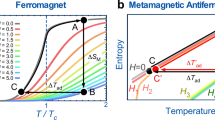Abstract
Magnetic refrigeration has been viewed as primarily a cryogenic technology because the necessary high magnetic fields are most easily provided by superconducting magnets. However, some of the largest magnetocaloric effects are exhibited by gadolinium-based alloys near room temperature. Ames Laboratory and Astronautics Corporation of America have been collaborating to apply such materials to large-scale commercial and industrial cooling near room temperature. Astronautics has designed and operated a reciprocating magnetic refrigerator that uses water as a heat transfer fluid. The device uses the active magnetic regeneration concept of recent cryogenic devices, but in contrast to the cryogenic case, the heat capacity of the fluid in the pores of the regenerator bed is comparable to that of the solid matrix. Using a 5 T field, the refrigerator reliably produces cooling powers exceeding 500 watts at coefficients of performance of 6 or more. This record performance puts magnetic refrigeration in a class with the best of current technology, vapor cycle refrigeration, without having to use volatile, environmentally hazardous fluids.
Access this chapter
Tax calculation will be finalised at checkout
Purchases are for personal use only
Preview
Unable to display preview. Download preview PDF.
Similar content being viewed by others
References
V.K. Pecharsky and K.A. Gschneidner Jr., Comparison of the magnetocaloric effect derived from heat capacity, direct, and magnetization measurements, in: “Advances in Cryogenic Engineering”, Vol 42, Plenum, New York (1996), p. 423
F.C. Chen, R.W. Murphy, V.C. Mei, and G.L. Chen, Thermodynamic analysis of four magnetic heat-pump cycles, J. of Eng. for Gas Turbines and Power, 114:715 (1992)
G.V. Brown, Magnetic heat pumping near room temperature, J. Appl. Phys. 47:3673 (1976)
G.V. Brown and S.S. Papell, Regeneration tests of a room temperature magnetic refrigerator and heat pump, unpublished (1978)
J.G. Purnell, Performance predictions for a room temperature, Ericsson cycle magnetic heat pump, DTNSRDC Report PAS-82–11, David Taylor Ship R&D Center, Annapolis (1982)
J.L. Hall, C.E. Reid, I.G. Spearing and J.A. Barclay, Thermodynamic considerations for the design of active magnetic regenerative refrigerators, in : “Advances in Cryogenic Engineering”, Vol 41, Plenum, New York (1996), p. 1653
A.J. DeGregoria, Modeling the active magnetic regenerator, in: “Advances in Cryogenic Engineering”, Vol 37, Plenum, New York (1992), p. 867
J.W. Johnson and C.B. Zimm, Performance modeling of a 4 K active magnetic regenerative refrigerator, J. Appl. Phys., 79:2171 (1996)
A.A. Wang, J.W. Johnson, R.W. Niemi, A.A. Sternberg, and C.B. Zimm, Experimental Results of an efficient active magnetic regenerator refrigerator, “Proceedings of the 8th International Cryocooler Conference”, Plenum, New York, (1995), p. 665
G. Green, J. Chafe, J. Stevens and J. Humphrey, A gadolinium-terbium active regenerator, in: “Advances in Cryogenic Engineering”, Vol 35, Plenum, New York (1990), p. 1165
F.W. Schmidt and A.J. Willmot, “Thermal Energy Storage and Regeneration”, McGraw-Hill, New York (1981)
C.R. Cross, J.A. Barclay, A.J. DeGregoria, S.R. Jaeger, and J.W. Johnson, Optimal temperature-entropy curves for magnetic refrigeration, in: “Advances in Cryogenic Engineering”, Vol 33, Plenum, New York (1987), p. 767
V.K. Pecharsky and K.A. Gschneidner Jr, Giant magnetocaloric effect in Gd5(Si2Ge2), Phys Rev Lett, 78:4494, 1997
Author information
Authors and Affiliations
Editor information
Editors and Affiliations
Rights and permissions
Copyright information
© 1998 Springer Science+Business Media New York
About this chapter
Cite this chapter
Zimm, C. et al. (1998). Description and Performance of a Near-Room Temperature Magnetic Refrigerator. In: Kittel, P. (eds) Advances in Cryogenic Engineering. Advances in Cryogenic Engineering, vol 43. Springer, Boston, MA. https://doi.org/10.1007/978-1-4757-9047-4_222
Download citation
DOI: https://doi.org/10.1007/978-1-4757-9047-4_222
Publisher Name: Springer, Boston, MA
Print ISBN: 978-1-4757-9049-8
Online ISBN: 978-1-4757-9047-4
eBook Packages: Springer Book Archive




